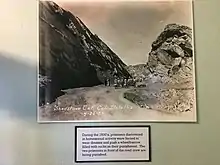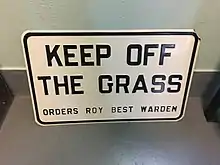Roy Best (prison warden)
Roy Best (March 2, 1900 – March 27, 1954)[1] was an American prison warden, film actor, and political candidate for Governor of Colorado. He is best remembered for his wardenship of the Colorado Territorial Correctional Facility (CTCF), an infamous prison in Cañon City, Colorado, and for playing himself in Canon City, the 1948 film noir crime film.
Roy P. Best | |
|---|---|
 Portrait of Roy Best, along with his Steamboat Pilot obituary, on display at the Colorado Prison Museum | |
| Born | March 2, 1900 |
| Died | May 27, 1954 (aged 54) |
| Occupation | |
| Spouse(s) | Mabel M. Best |
| Children | Harold David Best, Mc Ocel Best |
| Parent(s) | Boon Best, Carrie Blakely Best |
Early life
Roy Phelix Best was born on March 2, 1900 in Sheridan Lake, Colorado to parents Boon and Carrie Blakely Best.[2] In a harbinger of young Roy's career path, Colorado Governor William H. Adams appointed Roy's father Boon as warden of the Colorado Territorial Correctional Facility.[3] Adams would later appoint Roy as warden of the same facility, making them the first father and son appointed warden by the same Governor.[3]
Wardenship
Governor Adams appointed Roy as Colorado Territorial Correctional Facility Warden in 1932, when Roy was coincidentally thirty-two years of age.[4] This made Best the youngest warden in the history of the state and federal prison systems at that time.[4]

Best wasted no time earning his reputation as “the most notorious” warden in Colorado history.[5] A strict disciplinarian, Best pioneered the use of painful and degrading punishments inside and outside prison walls.[5] Among these was the “Old Gray Mare,” a wooden sawhorse on which inmates were bent-over, tied-down, and “flogged with a leather strap.”[5] Although Warden Best used the “Mare” as a means of punishment and deterrence, the device would later play a central role in the controversy that led to his removal.[6]
Homosexual prisoners also were unspared.[7] Early in Best's tenure, male prisoners caught in amorous liaisons “were forced to wear dresses and push a wheelbarrow filled with rocks as their punishment.”[8] A 1935 photograph documents the practice.[9]

But Best also pioneered modern rehabilitative penological practices.[5] He opened ranches, workshops, gardens, and other facilities to keep inmates busy, provide them with skills to earn a living upon release, and reduce the prison's operating costs.[5] Best also separated female prisoners from dangerous males, implemented a dental care program, and took young and developmentally-disabled inmates under his wing.[5]
Roy Best's defenders preferred to focus on these rehabilitative efforts.[10] “Many were led to believe that [Best] was unduly harsh and inhumane,” wrote The Steamboat Pilot upon his death, “[b]ut for those who knew him…he was an efficient operator of an institution that was difficult to handle.”[10]

Film career
A snowy, chaotic prison break was among the difficulties that confronted Best during his controversial tenure.[11] On December 30, 1947, twelve inmates escaped Best's prison in the thick of a snowstorm just before New Year's Eve.[11] Best organized a search party, and successfully captured or killed all of the escapees, “with most of the survivors suffering some degree of frostbite.”[11]
Hollywood wasted no time capitalizing on the dramatic events.[11] Just months later, director Crane Wilbur, actors Scott Brady. Jeff Corey, and Whit Bissell, and a film crew arrived at Best's prison gates to recreate the escape for the silver screen. The result was “Canon City,” a whirlwind film noir shot almost entirely on location and in the Royal Gorge area.
True to form, Warden Roy Best secured a central role in the film: playing himself.[12] Throughout Wilbur's gritty drama, Best can be seen inspecting the prison, explaining his duties, and coordinating the search efforts – all while wearing his trademark Stetson, with his two Dobermans, Chris and Ike, by his side.[13] The New York Times effusively praised Best's acting skills, writing that his performance evoked “a naturalness few actors could stimulate.”[12]
Political career
Even before the release of Canon City, Best was quick to capitalize on his newfound notoriety as warden of Colorado's state penitentiary. Best ran unopposed in the 1944 Democratic Primary for Governor of Colorado, earning over 34,000 votes. He proceeded to narrowly lose to Republican John Charles Vivian in the 1944 Colorado gubernatorial election.
But Best was to have the last laugh, as the sting from his loss to this “staunch fiscal conservative” was lessened by the self-sustaining nature of Best's prison operation. For as most state instrumentalities struggled under the so-called “spend nothing governor,” Best's prison ranches, workshops, gardens, and other facilities helped the prison remain profitable.[5]
Controversy and Death
Notwithstanding Best's successes inside and outside prison walls, the “Old Gray Mare” eventually caught up with him – and proved to be his undoing.[5]
By the early 1950s, word of Best's floggings had reached the public and spurred significant opprobrium.[5] In response, Governor Daniel I. J. Thornton launched an investigation and called for Best's removal.[5] A federal indictment followed, and Best faced a trial for violating his prisoners’ constitutional rights, among other misdeeds.[6][5]
Although the jury ultimately acquitted Best, the attention spurred a separate civil service inquest, which found that Best mixed his personal financial affairs with those of the prison.[5] The man who made his name doling out punishment thus faced a sanction of his own: a two-year suspension from his Wardenship of two decades.[5]
Best died from a heart attack on May 27, 1954, just three days short of the lifting of his suspension, and was buried at Lakeside Cemetery in Canon City, just two short miles of the prison.[5][2]
Legacy

Warden Roy Best's life remains controversial. Supporters remembered him as a “kindly man” who “took charge of the penitentiary when it was in a state of chaos.”[10] “When prisoners were whipped,” they wrote, “he did not ask someone else to do it. He did the job himself.”[10]
Others point to Best's brutal floggings,[5] humiliation of homosexuals,[7] financial misdeeds,[5] and relentless self-promotion as proof of the hypocrisy at the heart of the American penological model.[5]
Regardless, Roy Best remains inextricably linked with the culture of prisons and jails in the United States. Gardens and employment training remain in place to encourage good behavior and prepare inmates for the outside world.[14][15] The film Canon City remains a cult classic.[11] And each year, thousands of visitors learn from Roy Best's complicated legacy at the Colorado Prison Museum and elsewhere.[16]
“Because of the many attacks against him,” read Best's obituary, “many were led to believe he was unduly harsh and inhumane.”[10] “But for those who knew him,” the obituary continued, “they had a far different opinion.”[10]
References
- "Roy Best". IMDb.
- "Roy Phelix Best (1900-1954) - Find A Grave Memorial". Findagrave.com. Retrieved 2020-03-01.
- Information Card, Roy Best Office Display, Colorado Prison Museum (Last Visited January 2020)
- Colorado Prison Museum Guidebook, #4: Matron’s Office (2020)
- "Roy Best – Past, Present, Prison". Sites.coloradocollege.edu. Retrieved 2020-03-01.
- Jury Indicts Best, The Denver Post (April 22, 1952) (on display at Colorado Prison Museum)
- ‘Sandstone Cut,’ Colo. State Pen. (April 26, 1935) (on display at Colorado Prison Museum)
- Caption, ‘Sandstone Cut,’ Colo. State Pen. (April 26, 1935) (on display at Colorado Prison Museum)
- "Photo". upload.wikimedia.org. Retrieved 2020-04-16.
- Roy Best Obituary, The Steamboat Pilot (June 3, 1954) (on display at Colorado Prison Museum)
- 5/17/16 12:00AM (1947-12-30). "The bold, innovative Canon City deserves to be better known". Film.avclub.com. Retrieved 2020-03-01.
- "THE SCREEN; 'Canon City,' Semi-Documentary Film About Colorado Prison Break, at Loew's Criterion - The New York Times". Nytimes.com. Retrieved 2020-03-01.
- "Canon City | 1948 - FREE MOVIE! Improved Quality - Crime/Thriller/Action/True Story". YouTube. 2018-09-02. Retrieved 2020-03-01.
- Richard Schiffman. "The Secret Jailhouse Garden of Rikers Island - The New York Times". Nytimes.com. Retrieved 2020-03-01.
- Amy Chozick (2019-12-27). "The Rikers Coffee Academy - The New York Times". Nytimes.com. Retrieved 2020-03-01.
- "Home". Colorado Prison Museum.
| Party political offices | ||
|---|---|---|
| Preceded by Homer Bedford |
Democratic nominee for Governor of Colorado 1944 |
Succeeded by William Lee Knous |